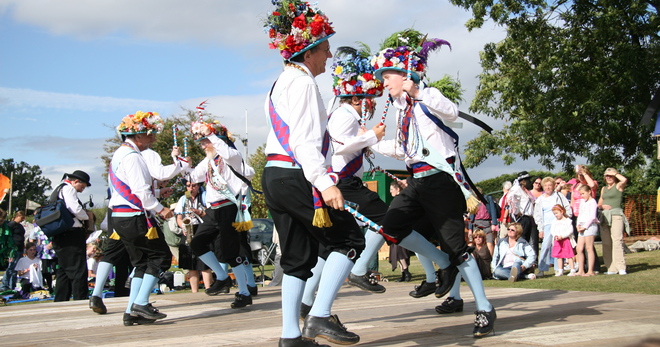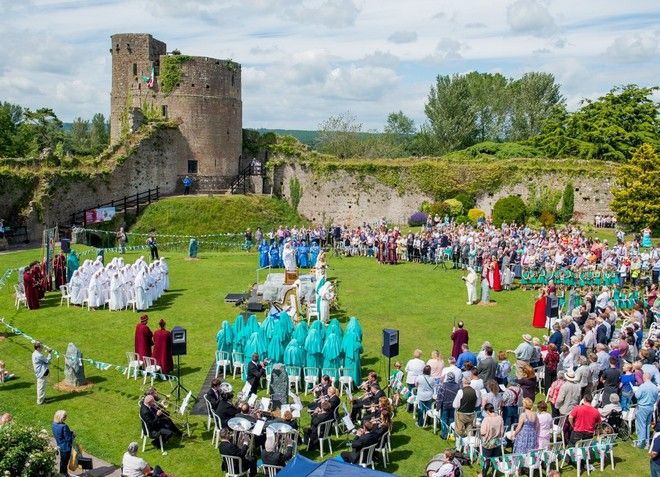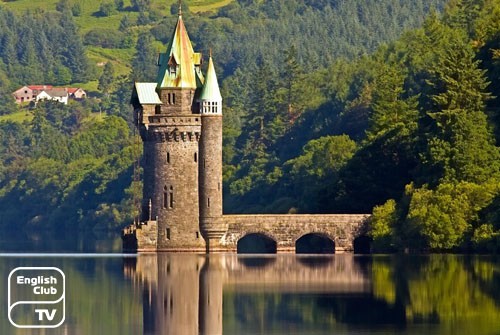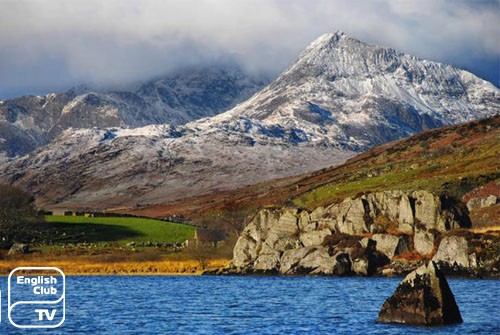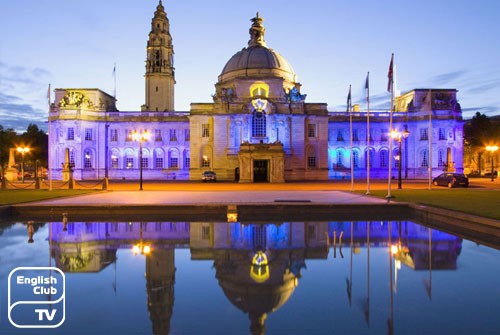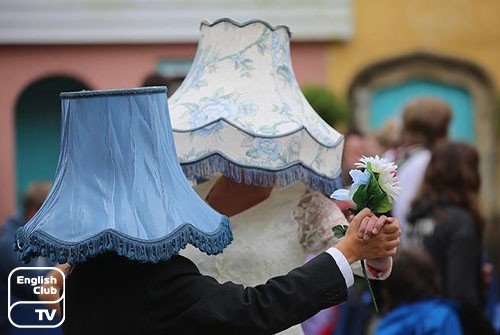Праздники Уэльса
Хотя Уэльс является частью Великобритании, его традиции и культура отличаются от других регионов Соединенного Королевства. Некоторые праздники Уэльса валлийцы отмечают вместе с другими жителями британских островов, но есть у них и собственные памятные дни.
Праздники и традиции Уэльса
К примеру, здесь существует собственный валлийский Новый год. После празднования Рождества валлийцы отмечают первый день года с ярмарками, музыкой и фейерверком в полночь. Утром принято обмениваться подарками и деньгами, а детей угощать шашлыком из яблок с изюмом и фруктами. Calening, так называется событие, празднуется по-разному в каждом регионе.
Ежегодно в Уэльс приезжают исполнители кельтской музыки на фестиваль Айстедворд, который проводится в августе. В этот день собирается почти 150 тыс. человек. Со сцены звучат в основном народные песни в исполнении бардов. Гости фестиваля не только знакомятся с музыкой, но и могут купить кельтские книги, посмотреть на ремесленников и их готовые работы.
Национальные праздники Уэльса
Многие валлийские традиции и обычаи берут начало в далеком прошлом. К самобытным праздникам относятся:
- Ночь Гая Фокса, которая отмечается каждый год в пятую ночь после Хэллоуина. Праздник легко распознать по разожженным кострам, на которых сжигают чучела. Праздник возник после неудавшейся попытки сжечь Вестминстерский дворец и убить короля.
- День перемирия, который отмечается с 1918 года, когда официально завершилась Первая мировая война. 11 ноября люди прикрепляют бутоньерки из алых маков к одежде в память о погибших на фронте. Выручка от продажи бутоньерок направляется в фонды помощи ветеранам.
- Праздник подарков или День Святого Стефана наступает на следующий день после Рождества. Это официальный выходной в Уэльсе. 26 декабря принято посещать приюты, дома престарелых, больницы. В этот день валлийцы обязательно дарят подарки не только членам семьи, но и сиротам, неимущим.
- День яблока отмечается 21 октября народными гуляниями, поеданием лакомств, выпечки. Устраиваются соревнования между лучниками, когда нужно попасть в яблоко с определенного расстояния. Каждая валлийская хозяйка готовит яблочные пироги, а садоводы закупают саженцы.
- День Святого Давида отмечают 1 марта. Традиция устраивать гуляния в этот день возникла в XVIII-XIX веках. Валлийцы прикрепляют к одежде лук-порей и нарциссы – символы Уэльса. По улицам городов проходят парады, шествие солдат валлийского полка. В пабах организуют концерты и театральные представления.
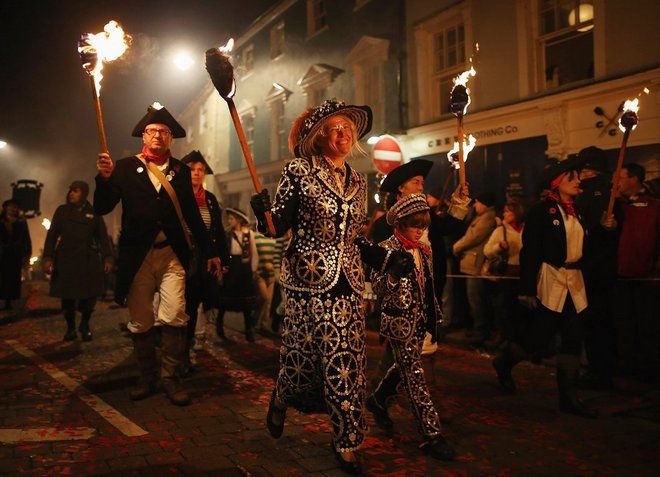
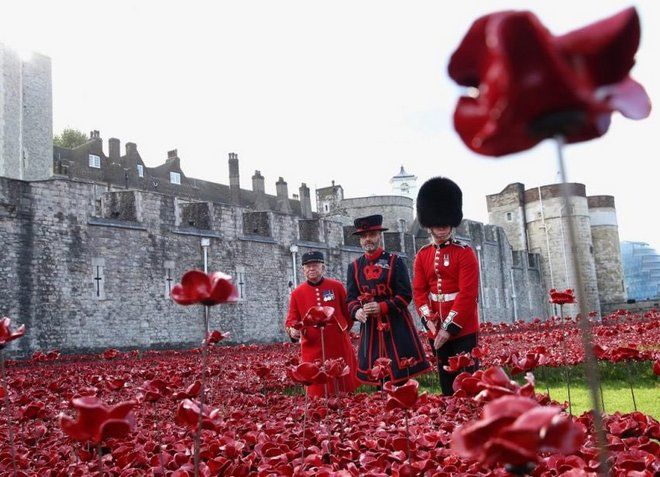
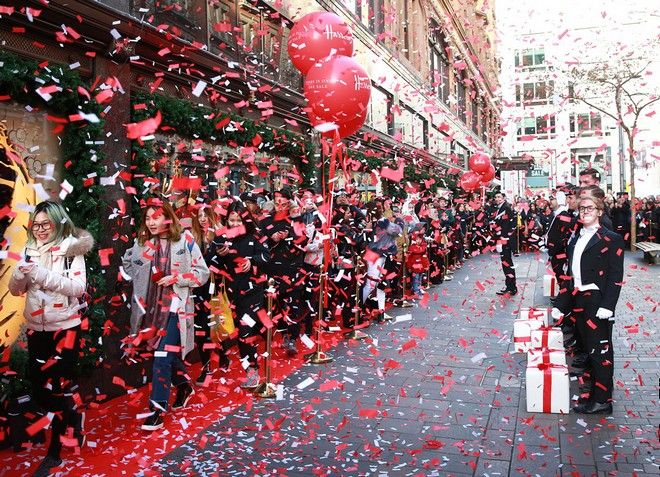
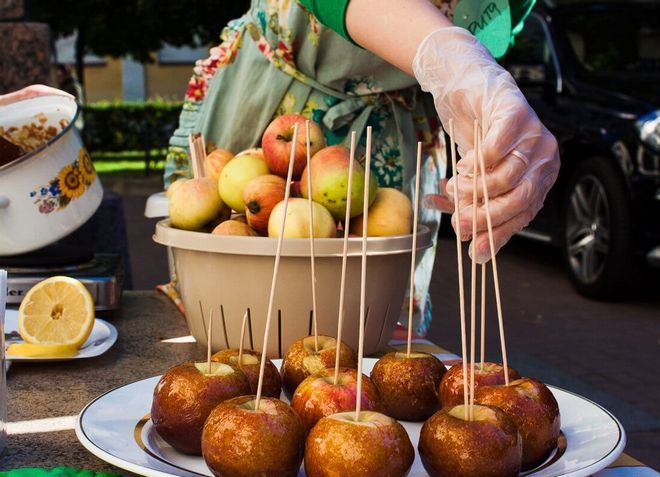
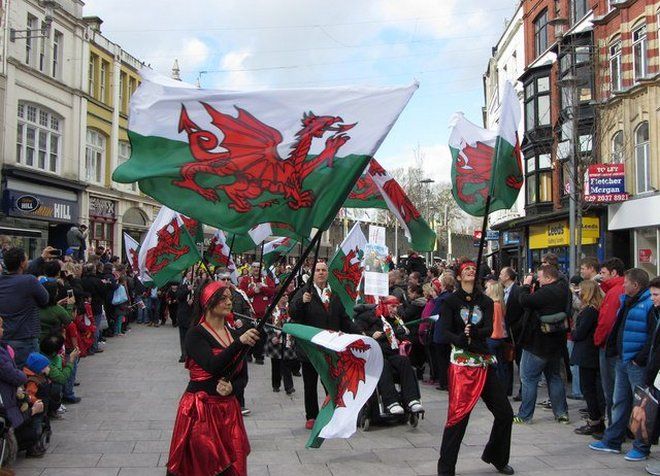
👁 16.1k (102 за неделю) ⏱️ 2 мин.
Несмотря на то, что Уэльс является частью Великобритании, культура и традиции этого края разительно отличаются от обычаев остальных стран, входящих в состав Соединенного Королевства. Некоторые знаменательные даты валлийцы отмечают вместе с жителями британских островов, есть у потомков древних кельтов и собственные, самобытные и оригинальные праздники.
День перемирия
Праздник относительно свежий, ему не исполнилось еще и ста лет, связан с официальным окончанием 11 ноября военных действий в I Мировой войне. Широко отмечается в Уэльсе, Нидерландах, Шотландии и США с 1918 года. В этот день люди крепят к одежде бутоньерки из алых маков, отдавая дань всем, кто погиб на фронте. Средства, полученные от реализации букетиков, направляются в фонд помощи ветеранам всех вооруженных конфликтов.
Ночь Гая Фокса
Второе название — Ночь костров, отмечают каждый год, на пятую ночь после Хэллоуина. История возникновения традиции относится к 1605 году, когда потерпел неудачу так называемый «пороховой заговор», целью которого было захватить и поджечь Вестминстерский дворец и лишить жизни правящего монарха. В честь благополучного спасения, король Яков I издал указ помнить день 5 ноября и отмечать его с размахом, что происходит и по сей день: на улицах жгут костры, запускают фейерверки.
Праздник Подарков
В стране древних кельтов является официальным выходным, отмечают его 26 декабря, а история его возникновения связана с такими понятиями как милосердие и благотворительность. Древняя христианская традиция пришла из католичества, и по-другому называется Днем Святого Стефана. В этот период принято помогать нуждающимся, посещать приюты, дома престарелых, больницы, дарить небольшие подарки сиротам и неимущим.
День яблока
Празднуют 21 октября и посвящают фрукту, откусив который, Ева совершила первородный грех. В программе народных гуляний – дегустации лакомств, выпечки и десертов из яблок, конкурсы, соревнования. Самое популярное состязание организовывают среди лучников, которые должны попасть в яблоко с определенного расстояния. Валлийские кулинары и простые хозяйки демонстрируют искусство приготовления фруктовых пирогов, а садоводы закупают молодые саженцы на ярмарках и сельскохозяйственных рынках.
День Святого Давида

Фестиваль кельтской культуры
Айстедворд – уникальное в своем роде соревнование между исполнителями кельтской музыки. Мероприятие ежегодно проводится в августе и собирает под одной крышей более 150 тысяч посетителей со всего мира. Уэльс на несколько дней становится одной большой концертной площадкой, на сцене которой выступают барды с репертуаром, состоящим исключительно из народных песен. В конкурсах на лучшее исполнение участвуют более 6000 певцов. Кроме музыки на фестивале можно познакомиться с народными ремеслами, приобрести кельтские книги и произведения местных умельцев.
From Wikipedia, the free encyclopedia
(Redirected from Welsh Holidays)
Various traditions are practiced on certain days of the year in Wales both currently and historically, including festivities originating in Welsh, Celtic, English and Christian cultures.
History[edit]
As recorded in the Laws of Hywel Dda, the three main holidays (gwyliau) of the medieval Welsh kingdoms were Christmas (Nadolig), Easter (Pasg), and Whitsuntide (Sulgwyn).[1]
Other important holidays were the feasts of St Patrick (Gwyl Badric) on 17 March; St. Quiricus (Gwyl Giric) on 16 June; the Beheading of John the Baptist (called in Welsh Gwyl Ieuan y Moch – St. John of the Swine – as it was the day the pigs were turned out into the woods to forage through the winter[2]) on 29 August; St Michael (Gwyl Fihangel) on 29 September; and the Calends of Winter (Calan Gaeaf) on 1 November, All Saints’ Day (yr Holl Saint).[3] A special drink called the «liquor of the Apostles» (gwirawd yr ebestyl) was brewed for and distributed on these saints’ days.[4]
Modern celebrations[edit]
New Year’s Eve – 31 December[edit]
New year’s eve in Wales nowadays includes attending pantomimes, theatre shows and parties.[5] The Nos Galan road race is also held in Mountain Ash.[6]
Hen Galan (Old New Year) – 14 January[edit]
The Mari Lwyd («Grey Mare») is a horse-figure that is carried from door to door by wassail-singing groups during Hen Galan (Old New Year) celebrations in some communities in Wales.[7][8][9]
St Dwynwen’s Day (Dydd Santes Dwynwen) – 25 January[edit]
Celebrated on 25 January every year, St Dwynwen Day (Dydd Santes Dwynwen) is the Welsh day of love, equivalent to St. Valentine’s Day.[10]
St David’s Day (Dydd Gwyl Dewi) – 1 March[edit]
The patron saint of Wales is St David (Welsh: Dewi Sant) and St. David’s Day (Dydd Gŵyl Dewi Sant) is celebrated on 1 March.[11] Some people argue it should be designated as a bank holiday.
Easter Sunday (Sul y Pasg)[edit]
On Easter Sunday, children receive chocolate easter eggs from the «easter bunny» and engage in chocolate egg hunts. Hot cross bunns are eaten and Easter greetings include «Happy Easter» in English or «Pasg Hapus» in Welsh.[12][13]
Shrove Tuesday (Dydd Mawrth Ynyd) or Pancake Day[edit]
Shrove Tuesday was historically held on the eve of the Christian fasting period of Lent, and is traditionally celebrated with the making of pancakes.[14]
Owain Glyndŵr Day (Diwrnod Glyndŵr) – 16 September[edit]
Although not a traditional holiday, many schools and organisations now commemorate the 16 September as a commemoration of Owain Glyndŵr, with festivals such as Gŵyl y Fflam (Festival of the flame) to celebrate it.[15][16][17] In addition, towns with particular links to Glyndwr celebrate the day, including Corwen and Harlech.[18][19]
Calan Gaeaf – 31 October – 1 November[edit]
Historically, a commemoration of end of the autumn and harvest season and the beginning of winter. It has Celtic origins which merged with the Christian tradition.[20][failed verification – see discussion]
Bonfire Night (Noson Tân Gwyllt) – 5 November[edit]
On 5th of November, a night of fireworks occurs that began after Guy Fawkes attempted to blow up the Houses of Parliament in England.[14]
Christmas (Nadolig) – 25 December[edit]
Christmas in Wales traditionally involved singing Plygain, toffee-making and torch processions in Wales.[21]
Boxing Day / St Stephen’s Day (Gwyl San Steffan) – 26 December[edit]
Celebrated on 26 December, in Wales Boxing Day or St. Stephen’s Day is known as Gŵyl San Steffan in Welsh.[22]
Festivals no longer widely celebrated[edit]
These are festivals that were once widely celebrated in Wales but are no longer so.[citation needed]
Calennig is a tradition where children carry a decorated apple, pierced with three sticks and decorated with a sprig of box and hazelnuts on new year’s day. Children would sing a verse and were often gifted with money or food.[23]
Gŵyl Fair y Canhwyllau usually on the 2 February, literally translates as «Mary’s Festival of the Candles» marked the coming of Spring in Wales.[14]
Locally, each parish[clarification needed] celebrated a Gŵyl Mabsant in commemoration of its native saint. This annual celebration developed from a dedication through prayer to a programme of recreational activities.[24]
Calan Mai (or Calan Had) is a May Day celebration on 1 May, marking the first day of summer and the Welsh equivalent of Beltane.[citation needed]
Gwyl Ifan (St John’s Day) on the 24 June is otherwise known as Midsummer’s day.[citation needed]
External links[edit]
- A list of other Medieval Welsh saints’ days at Aberystwyth University (under «gwyl»)
References[edit]
- ^ Wade-Evans, Arthur. Welsh Medieval Laws, p. 2. Oxford Univ., 1909. Accessed 31 Jan. 2013.
- ^ Roberts, Sara E. Llawysgrif Pomffred: An Edition and Study of Peniarth MS 259B. Brill, 2011. Accessed 31 Jan 2013.
- ^ Wade-Evans, Arthur. Welsh Medieval Laws, p. 343. Oxford University, 1909. Accessed 31 Jan 2013.
- ^ Wade-Evans, Arthur. Welsh Medieval Laws, p. 341. Oxford Univ., 1909. Accessed 31 Jan. 2013.
- ^ Stephens, Lydia (2022-12-28). «The biggest New Year’s Eve events in Cardiff you can still get tickets for». WalesOnline. Retrieved 2023-01-20.
- ^ «Christmas in Wales and New Year break ideas». VisitWales. Retrieved 2023-01-20.
- ^ «Christmas Traditions: The Mari Lwyd». Museum Wales. Retrieved 2022-10-02.
- ^ «The Mari Lwyd». Wales. 2019-12-13. Retrieved 2022-10-02.
- ^ «Watch: Mari Lwyd appears at Hen Galan celebrations around Wales». Nation.Cymru. 2023-01-14. Retrieved 2023-01-15.
- ^ «Celebrate St Dwynwen’s Day». VisitWales. Retrieved 2022-10-02.
- ^ «St David’s Day celebration traditions». VisitWales. Retrieved 2022-10-02.
- ^ Hestler, Anna; Spilling, Jo-Ann; Scirri, Kaitlin (2020-04-15). Wales. Cavendish Square Publishing, LLC. p. 121. ISBN 978-1-5026-5584-4.
- ^ Crump, William D. (2021-02-22). Encyclopedia of Easter Celebrations Worldwide. McFarland. p. 276. ISBN 978-1-4766-8054-5.
- ^ a b c «A year in Wales». Wales. 2019-07-01. Retrieved 2022-10-02.
- ^ «Mold Schoolchildren celebrate Owain Gyndwr». dailypost.co.uk. 18 April 2013.
- ^ Arron Evans (8 September 2019). «Corwen’s Gwyl Y Fflam Festival to give guests unique look into Owain Glyndwr’s home». denbighshirefreepress.co.uk.
- ^ Adam Jones (11 September 2015). «Celebrting Owain Glyndŵr’s day».
- ^ «Corwen to celebrate Owain Glyndwr Day — as King Charles makes first Wales visit as monarch». The Leader. Retrieved 2022-09-15.
- ^ «Harlech cancels procession out of respect for the Queen | cambrian-news.co.uk». Cambrian News. 2022-09-08. Retrieved 2022-09-15.
- ^ «Table 4: Changes in BC at the end of the previous season, at the beginning of the pre-season (after the off-season period) and at the end of the retraining period (pre-season)». dx.doi.org. doi:10.7717/peerj.7466/table-4. Retrieved 2022-10-02.
- ^ «Welsh Christmas Traditions». Wales. 2019-12-12. Retrieved 2023-01-20.
- ^ «A Traditional Welsh Christmas — Christmas celebrations in Wales». Historic UK. Retrieved 2022-10-02.
- ^ «New Year Traditions: Collecting Calennig». Museum Wales. Retrieved 2022-10-02.
- ^ «The forgotten festivals of Wales». Museum Wales. Retrieved 2022-10-02.
From Wikipedia, the free encyclopedia
(Redirected from Welsh Holidays)
Various traditions are practiced on certain days of the year in Wales both currently and historically, including festivities originating in Welsh, Celtic, English and Christian cultures.
History[edit]
As recorded in the Laws of Hywel Dda, the three main holidays (gwyliau) of the medieval Welsh kingdoms were Christmas (Nadolig), Easter (Pasg), and Whitsuntide (Sulgwyn).[1]
Other important holidays were the feasts of St Patrick (Gwyl Badric) on 17 March; St. Quiricus (Gwyl Giric) on 16 June; the Beheading of John the Baptist (called in Welsh Gwyl Ieuan y Moch – St. John of the Swine – as it was the day the pigs were turned out into the woods to forage through the winter[2]) on 29 August; St Michael (Gwyl Fihangel) on 29 September; and the Calends of Winter (Calan Gaeaf) on 1 November, All Saints’ Day (yr Holl Saint).[3] A special drink called the «liquor of the Apostles» (gwirawd yr ebestyl) was brewed for and distributed on these saints’ days.[4]
Modern celebrations[edit]
New Year’s Eve – 31 December[edit]
New year’s eve in Wales nowadays includes attending pantomimes, theatre shows and parties.[5] The Nos Galan road race is also held in Mountain Ash.[6]
Hen Galan (Old New Year) – 14 January[edit]
The Mari Lwyd («Grey Mare») is a horse-figure that is carried from door to door by wassail-singing groups during Hen Galan (Old New Year) celebrations in some communities in Wales.[7][8][9]
St Dwynwen’s Day (Dydd Santes Dwynwen) – 25 January[edit]
Celebrated on 25 January every year, St Dwynwen Day (Dydd Santes Dwynwen) is the Welsh day of love, equivalent to St. Valentine’s Day.[10]
St David’s Day (Dydd Gwyl Dewi) – 1 March[edit]
The patron saint of Wales is St David (Welsh: Dewi Sant) and St. David’s Day (Dydd Gŵyl Dewi Sant) is celebrated on 1 March.[11] Some people argue it should be designated as a bank holiday.
Easter Sunday (Sul y Pasg)[edit]
On Easter Sunday, children receive chocolate easter eggs from the «easter bunny» and engage in chocolate egg hunts. Hot cross bunns are eaten and Easter greetings include «Happy Easter» in English or «Pasg Hapus» in Welsh.[12][13]
Shrove Tuesday (Dydd Mawrth Ynyd) or Pancake Day[edit]
Shrove Tuesday was historically held on the eve of the Christian fasting period of Lent, and is traditionally celebrated with the making of pancakes.[14]
Owain Glyndŵr Day (Diwrnod Glyndŵr) – 16 September[edit]
Although not a traditional holiday, many schools and organisations now commemorate the 16 September as a commemoration of Owain Glyndŵr, with festivals such as Gŵyl y Fflam (Festival of the flame) to celebrate it.[15][16][17] In addition, towns with particular links to Glyndwr celebrate the day, including Corwen and Harlech.[18][19]
Calan Gaeaf – 31 October – 1 November[edit]
Historically, a commemoration of end of the autumn and harvest season and the beginning of winter. It has Celtic origins which merged with the Christian tradition.[20][failed verification – see discussion]
Bonfire Night (Noson Tân Gwyllt) – 5 November[edit]
On 5th of November, a night of fireworks occurs that began after Guy Fawkes attempted to blow up the Houses of Parliament in England.[14]
Christmas (Nadolig) – 25 December[edit]
Christmas in Wales traditionally involved singing Plygain, toffee-making and torch processions in Wales.[21]
Boxing Day / St Stephen’s Day (Gwyl San Steffan) – 26 December[edit]
Celebrated on 26 December, in Wales Boxing Day or St. Stephen’s Day is known as Gŵyl San Steffan in Welsh.[22]
Festivals no longer widely celebrated[edit]
These are festivals that were once widely celebrated in Wales but are no longer so.[citation needed]
Calennig is a tradition where children carry a decorated apple, pierced with three sticks and decorated with a sprig of box and hazelnuts on new year’s day. Children would sing a verse and were often gifted with money or food.[23]
Gŵyl Fair y Canhwyllau usually on the 2 February, literally translates as «Mary’s Festival of the Candles» marked the coming of Spring in Wales.[14]
Locally, each parish[clarification needed] celebrated a Gŵyl Mabsant in commemoration of its native saint. This annual celebration developed from a dedication through prayer to a programme of recreational activities.[24]
Calan Mai (or Calan Had) is a May Day celebration on 1 May, marking the first day of summer and the Welsh equivalent of Beltane.[citation needed]
Gwyl Ifan (St John’s Day) on the 24 June is otherwise known as Midsummer’s day.[citation needed]
External links[edit]
- A list of other Medieval Welsh saints’ days at Aberystwyth University (under «gwyl»)
References[edit]
- ^ Wade-Evans, Arthur. Welsh Medieval Laws, p. 2. Oxford Univ., 1909. Accessed 31 Jan. 2013.
- ^ Roberts, Sara E. Llawysgrif Pomffred: An Edition and Study of Peniarth MS 259B. Brill, 2011. Accessed 31 Jan 2013.
- ^ Wade-Evans, Arthur. Welsh Medieval Laws, p. 343. Oxford University, 1909. Accessed 31 Jan 2013.
- ^ Wade-Evans, Arthur. Welsh Medieval Laws, p. 341. Oxford Univ., 1909. Accessed 31 Jan. 2013.
- ^ Stephens, Lydia (2022-12-28). «The biggest New Year’s Eve events in Cardiff you can still get tickets for». WalesOnline. Retrieved 2023-01-20.
- ^ «Christmas in Wales and New Year break ideas». VisitWales. Retrieved 2023-01-20.
- ^ «Christmas Traditions: The Mari Lwyd». Museum Wales. Retrieved 2022-10-02.
- ^ «The Mari Lwyd». Wales. 2019-12-13. Retrieved 2022-10-02.
- ^ «Watch: Mari Lwyd appears at Hen Galan celebrations around Wales». Nation.Cymru. 2023-01-14. Retrieved 2023-01-15.
- ^ «Celebrate St Dwynwen’s Day». VisitWales. Retrieved 2022-10-02.
- ^ «St David’s Day celebration traditions». VisitWales. Retrieved 2022-10-02.
- ^ Hestler, Anna; Spilling, Jo-Ann; Scirri, Kaitlin (2020-04-15). Wales. Cavendish Square Publishing, LLC. p. 121. ISBN 978-1-5026-5584-4.
- ^ Crump, William D. (2021-02-22). Encyclopedia of Easter Celebrations Worldwide. McFarland. p. 276. ISBN 978-1-4766-8054-5.
- ^ a b c «A year in Wales». Wales. 2019-07-01. Retrieved 2022-10-02.
- ^ «Mold Schoolchildren celebrate Owain Gyndwr». dailypost.co.uk. 18 April 2013.
- ^ Arron Evans (8 September 2019). «Corwen’s Gwyl Y Fflam Festival to give guests unique look into Owain Glyndwr’s home». denbighshirefreepress.co.uk.
- ^ Adam Jones (11 September 2015). «Celebrting Owain Glyndŵr’s day».
- ^ «Corwen to celebrate Owain Glyndwr Day — as King Charles makes first Wales visit as monarch». The Leader. Retrieved 2022-09-15.
- ^ «Harlech cancels procession out of respect for the Queen | cambrian-news.co.uk». Cambrian News. 2022-09-08. Retrieved 2022-09-15.
- ^ «Table 4: Changes in BC at the end of the previous season, at the beginning of the pre-season (after the off-season period) and at the end of the retraining period (pre-season)». dx.doi.org. doi:10.7717/peerj.7466/table-4. Retrieved 2022-10-02.
- ^ «Welsh Christmas Traditions». Wales. 2019-12-12. Retrieved 2023-01-20.
- ^ «A Traditional Welsh Christmas — Christmas celebrations in Wales». Historic UK. Retrieved 2022-10-02.
- ^ «New Year Traditions: Collecting Calennig». Museum Wales. Retrieved 2022-10-02.
- ^ «The forgotten festivals of Wales». Museum Wales. Retrieved 2022-10-02.
From Wikipedia, the free encyclopedia
Various traditions are practiced on certain days of the year in Wales both currently and historically, including festivities originating in Welsh, Celtic, English and Christian cultures.
History[edit]
As recorded in the Laws of Hywel Dda, the three main holidays (gwyliau) of the medieval Welsh kingdoms were Christmas (Nadolig), Easter (Pasg), and Whitsuntide (Sulgwyn).[1]
Other important holidays were the feasts of St Patrick (Gwyl Badric) on 17 March; St. Quiricus (Gwyl Giric) on 16 June; the Beheading of John the Baptist (called in Welsh Gwyl Ieuan y Moch – St. John of the Swine – as it was the day the pigs were turned out into the woods to forage through the winter[2]) on 29 August; St Michael (Gwyl Fihangel) on 29 September; and the Calends of Winter (Calan Gaeaf) on 1 November, All Saints’ Day (yr Holl Saint).[3] A special drink called the «liquor of the Apostles» (gwirawd yr ebestyl) was brewed for and distributed on these saints’ days.[4]
Modern celebrations[edit]
New Year’s Eve – 31 December[edit]
New year’s eve in Wales nowadays includes attending pantomimes, theatre shows and parties.[5] The Nos Galan road race is also held in Mountain Ash.[6]
Hen Galan (Old New Year) – 14 January[edit]
The Mari Lwyd («Grey Mare») is a horse-figure that is carried from door to door by wassail-singing groups during Hen Galan (Old New Year) celebrations in some communities in Wales.[7][8][9]
St Dwynwen’s Day (Dydd Santes Dwynwen) – 25 January[edit]
Celebrated on 25 January every year, St Dwynwen Day (Dydd Santes Dwynwen) is the Welsh day of love, equivalent to St. Valentine’s Day.[10]
St David’s Day (Dydd Gwyl Dewi) – 1 March[edit]
The patron saint of Wales is St David (Welsh: Dewi Sant) and St. David’s Day (Dydd Gŵyl Dewi Sant) is celebrated on 1 March.[11] Some people argue it should be designated as a bank holiday.
Easter Sunday (Sul y Pasg)[edit]
On Easter Sunday, children receive chocolate easter eggs from the «easter bunny» and engage in chocolate egg hunts. Hot cross bunns are eaten and Easter greetings include «Happy Easter» in English or «Pasg Hapus» in Welsh.[12][13]
Shrove Tuesday (Dydd Mawrth Ynyd) or Pancake Day[edit]
Shrove Tuesday was historically held on the eve of the Christian fasting period of Lent, and is traditionally celebrated with the making of pancakes.[14]
Owain Glyndŵr Day (Diwrnod Glyndŵr) – 16 September[edit]
Although not a traditional holiday, many schools and organisations now commemorate the 16 September as a commemoration of Owain Glyndŵr, with festivals such as Gŵyl y Fflam (Festival of the flame) to celebrate it.[15][16][17] In addition, towns with particular links to Glyndwr celebrate the day, including Corwen and Harlech.[18][19]
Calan Gaeaf – 31 October – 1 November[edit]
Historically, a commemoration of end of the autumn and harvest season and the beginning of winter. It has Celtic origins which merged with the Christian tradition.[20][failed verification – see discussion]
Bonfire Night (Noson Tân Gwyllt) – 5 November[edit]
On 5th of November, a night of fireworks occurs that began after Guy Fawkes attempted to blow up the Houses of Parliament in England.[14]
Christmas (Nadolig) – 25 December[edit]
Christmas in Wales traditionally involved singing Plygain, toffee-making and torch processions in Wales.[21]
Boxing Day / St Stephen’s Day (Gwyl San Steffan) – 26 December[edit]
Celebrated on 26 December, in Wales Boxing Day or St. Stephen’s Day is known as Gŵyl San Steffan in Welsh.[22]
Festivals no longer widely celebrated[edit]
These are festivals that were once widely celebrated in Wales but are no longer so.[citation needed]
Calennig is a tradition where children carry a decorated apple, pierced with three sticks and decorated with a sprig of box and hazelnuts on new year’s day. Children would sing a verse and were often gifted with money or food.[23]
Gŵyl Fair y Canhwyllau usually on the 2 February, literally translates as «Mary’s Festival of the Candles» marked the coming of Spring in Wales.[14]
Locally, each parish[clarification needed] celebrated a Gŵyl Mabsant in commemoration of its native saint. This annual celebration developed from a dedication through prayer to a programme of recreational activities.[24]
Calan Mai (or Calan Had) is a May Day celebration on 1 May, marking the first day of summer and the Welsh equivalent of Beltane.[citation needed]
Gwyl Ifan (St John’s Day) on the 24 June is otherwise known as Midsummer’s day.[citation needed]
External links[edit]
- A list of other Medieval Welsh saints’ days at Aberystwyth University (under «gwyl»)
References[edit]
- ^ Wade-Evans, Arthur. Welsh Medieval Laws, p. 2. Oxford Univ., 1909. Accessed 31 Jan. 2013.
- ^ Roberts, Sara E. Llawysgrif Pomffred: An Edition and Study of Peniarth MS 259B. Brill, 2011. Accessed 31 Jan 2013.
- ^ Wade-Evans, Arthur. Welsh Medieval Laws, p. 343. Oxford University, 1909. Accessed 31 Jan 2013.
- ^ Wade-Evans, Arthur. Welsh Medieval Laws, p. 341. Oxford Univ., 1909. Accessed 31 Jan. 2013.
- ^ Stephens, Lydia (2022-12-28). «The biggest New Year’s Eve events in Cardiff you can still get tickets for». WalesOnline. Retrieved 2023-01-20.
- ^ «Christmas in Wales and New Year break ideas». VisitWales. Retrieved 2023-01-20.
- ^ «Christmas Traditions: The Mari Lwyd». Museum Wales. Retrieved 2022-10-02.
- ^ «The Mari Lwyd». Wales. 2019-12-13. Retrieved 2022-10-02.
- ^ «Watch: Mari Lwyd appears at Hen Galan celebrations around Wales». Nation.Cymru. 2023-01-14. Retrieved 2023-01-15.
- ^ «Celebrate St Dwynwen’s Day». VisitWales. Retrieved 2022-10-02.
- ^ «St David’s Day celebration traditions». VisitWales. Retrieved 2022-10-02.
- ^ Hestler, Anna; Spilling, Jo-Ann; Scirri, Kaitlin (2020-04-15). Wales. Cavendish Square Publishing, LLC. p. 121. ISBN 978-1-5026-5584-4.
- ^ Crump, William D. (2021-02-22). Encyclopedia of Easter Celebrations Worldwide. McFarland. p. 276. ISBN 978-1-4766-8054-5.
- ^ a b c «A year in Wales». Wales. 2019-07-01. Retrieved 2022-10-02.
- ^ «Mold Schoolchildren celebrate Owain Gyndwr». dailypost.co.uk. 18 April 2013.
- ^ Arron Evans (8 September 2019). «Corwen’s Gwyl Y Fflam Festival to give guests unique look into Owain Glyndwr’s home». denbighshirefreepress.co.uk.
- ^ Adam Jones (11 September 2015). «Celebrting Owain Glyndŵr’s day».
- ^ «Corwen to celebrate Owain Glyndwr Day — as King Charles makes first Wales visit as monarch». The Leader. Retrieved 2022-09-15.
- ^ «Harlech cancels procession out of respect for the Queen | cambrian-news.co.uk». Cambrian News. 2022-09-08. Retrieved 2022-09-15.
- ^ «Table 4: Changes in BC at the end of the previous season, at the beginning of the pre-season (after the off-season period) and at the end of the retraining period (pre-season)». dx.doi.org. doi:10.7717/peerj.7466/table-4. Retrieved 2022-10-02.
- ^ «Welsh Christmas Traditions». Wales. 2019-12-12. Retrieved 2023-01-20.
- ^ «A Traditional Welsh Christmas — Christmas celebrations in Wales». Historic UK. Retrieved 2022-10-02.
- ^ «New Year Traditions: Collecting Calennig». Museum Wales. Retrieved 2022-10-02.
- ^ «The forgotten festivals of Wales». Museum Wales. Retrieved 2022-10-02.
From Wikipedia, the free encyclopedia
Various traditions are practiced on certain days of the year in Wales both currently and historically, including festivities originating in Welsh, Celtic, English and Christian cultures.
History[edit]
As recorded in the Laws of Hywel Dda, the three main holidays (gwyliau) of the medieval Welsh kingdoms were Christmas (Nadolig), Easter (Pasg), and Whitsuntide (Sulgwyn).[1]
Other important holidays were the feasts of St Patrick (Gwyl Badric) on 17 March; St. Quiricus (Gwyl Giric) on 16 June; the Beheading of John the Baptist (called in Welsh Gwyl Ieuan y Moch – St. John of the Swine – as it was the day the pigs were turned out into the woods to forage through the winter[2]) on 29 August; St Michael (Gwyl Fihangel) on 29 September; and the Calends of Winter (Calan Gaeaf) on 1 November, All Saints’ Day (yr Holl Saint).[3] A special drink called the «liquor of the Apostles» (gwirawd yr ebestyl) was brewed for and distributed on these saints’ days.[4]
Modern celebrations[edit]
New Year’s Eve – 31 December[edit]
New year’s eve in Wales nowadays includes attending pantomimes, theatre shows and parties.[5] The Nos Galan road race is also held in Mountain Ash.[6]
Hen Galan (Old New Year) – 14 January[edit]
The Mari Lwyd («Grey Mare») is a horse-figure that is carried from door to door by wassail-singing groups during Hen Galan (Old New Year) celebrations in some communities in Wales.[7][8][9]
St Dwynwen’s Day (Dydd Santes Dwynwen) – 25 January[edit]
Celebrated on 25 January every year, St Dwynwen Day (Dydd Santes Dwynwen) is the Welsh day of love, equivalent to St. Valentine’s Day.[10]
St David’s Day (Dydd Gwyl Dewi) – 1 March[edit]
The patron saint of Wales is St David (Welsh: Dewi Sant) and St. David’s Day (Dydd Gŵyl Dewi Sant) is celebrated on 1 March.[11] Some people argue it should be designated as a bank holiday.
Easter Sunday (Sul y Pasg)[edit]
On Easter Sunday, children receive chocolate easter eggs from the «easter bunny» and engage in chocolate egg hunts. Hot cross bunns are eaten and Easter greetings include «Happy Easter» in English or «Pasg Hapus» in Welsh.[12][13]
Shrove Tuesday (Dydd Mawrth Ynyd) or Pancake Day[edit]
Shrove Tuesday was historically held on the eve of the Christian fasting period of Lent, and is traditionally celebrated with the making of pancakes.[14]
Owain Glyndŵr Day (Diwrnod Glyndŵr) – 16 September[edit]
Although not a traditional holiday, many schools and organisations now commemorate the 16 September as a commemoration of Owain Glyndŵr, with festivals such as Gŵyl y Fflam (Festival of the flame) to celebrate it.[15][16][17] In addition, towns with particular links to Glyndwr celebrate the day, including Corwen and Harlech.[18][19]
Calan Gaeaf – 31 October – 1 November[edit]
Historically, a commemoration of end of the autumn and harvest season and the beginning of winter. It has Celtic origins which merged with the Christian tradition.[20][failed verification – see discussion]
Bonfire Night (Noson Tân Gwyllt) – 5 November[edit]
On 5th of November, a night of fireworks occurs that began after Guy Fawkes attempted to blow up the Houses of Parliament in England.[14]
Christmas (Nadolig) – 25 December[edit]
Christmas in Wales traditionally involved singing Plygain, toffee-making and torch processions in Wales.[21]
Boxing Day / St Stephen’s Day (Gwyl San Steffan) – 26 December[edit]
Celebrated on 26 December, in Wales Boxing Day or St. Stephen’s Day is known as Gŵyl San Steffan in Welsh.[22]
Festivals no longer widely celebrated[edit]
These are festivals that were once widely celebrated in Wales but are no longer so.[citation needed]
Calennig is a tradition where children carry a decorated apple, pierced with three sticks and decorated with a sprig of box and hazelnuts on new year’s day. Children would sing a verse and were often gifted with money or food.[23]
Gŵyl Fair y Canhwyllau usually on the 2 February, literally translates as «Mary’s Festival of the Candles» marked the coming of Spring in Wales.[14]
Locally, each parish[clarification needed] celebrated a Gŵyl Mabsant in commemoration of its native saint. This annual celebration developed from a dedication through prayer to a programme of recreational activities.[24]
Calan Mai (or Calan Had) is a May Day celebration on 1 May, marking the first day of summer and the Welsh equivalent of Beltane.[citation needed]
Gwyl Ifan (St John’s Day) on the 24 June is otherwise known as Midsummer’s day.[citation needed]
External links[edit]
- A list of other Medieval Welsh saints’ days at Aberystwyth University (under «gwyl»)
References[edit]
- ^ Wade-Evans, Arthur. Welsh Medieval Laws, p. 2. Oxford Univ., 1909. Accessed 31 Jan. 2013.
- ^ Roberts, Sara E. Llawysgrif Pomffred: An Edition and Study of Peniarth MS 259B. Brill, 2011. Accessed 31 Jan 2013.
- ^ Wade-Evans, Arthur. Welsh Medieval Laws, p. 343. Oxford University, 1909. Accessed 31 Jan 2013.
- ^ Wade-Evans, Arthur. Welsh Medieval Laws, p. 341. Oxford Univ., 1909. Accessed 31 Jan. 2013.
- ^ Stephens, Lydia (2022-12-28). «The biggest New Year’s Eve events in Cardiff you can still get tickets for». WalesOnline. Retrieved 2023-01-20.
- ^ «Christmas in Wales and New Year break ideas». VisitWales. Retrieved 2023-01-20.
- ^ «Christmas Traditions: The Mari Lwyd». Museum Wales. Retrieved 2022-10-02.
- ^ «The Mari Lwyd». Wales. 2019-12-13. Retrieved 2022-10-02.
- ^ «Watch: Mari Lwyd appears at Hen Galan celebrations around Wales». Nation.Cymru. 2023-01-14. Retrieved 2023-01-15.
- ^ «Celebrate St Dwynwen’s Day». VisitWales. Retrieved 2022-10-02.
- ^ «St David’s Day celebration traditions». VisitWales. Retrieved 2022-10-02.
- ^ Hestler, Anna; Spilling, Jo-Ann; Scirri, Kaitlin (2020-04-15). Wales. Cavendish Square Publishing, LLC. p. 121. ISBN 978-1-5026-5584-4.
- ^ Crump, William D. (2021-02-22). Encyclopedia of Easter Celebrations Worldwide. McFarland. p. 276. ISBN 978-1-4766-8054-5.
- ^ a b c «A year in Wales». Wales. 2019-07-01. Retrieved 2022-10-02.
- ^ «Mold Schoolchildren celebrate Owain Gyndwr». dailypost.co.uk. 18 April 2013.
- ^ Arron Evans (8 September 2019). «Corwen’s Gwyl Y Fflam Festival to give guests unique look into Owain Glyndwr’s home». denbighshirefreepress.co.uk.
- ^ Adam Jones (11 September 2015). «Celebrting Owain Glyndŵr’s day».
- ^ «Corwen to celebrate Owain Glyndwr Day — as King Charles makes first Wales visit as monarch». The Leader. Retrieved 2022-09-15.
- ^ «Harlech cancels procession out of respect for the Queen | cambrian-news.co.uk». Cambrian News. 2022-09-08. Retrieved 2022-09-15.
- ^ «Table 4: Changes in BC at the end of the previous season, at the beginning of the pre-season (after the off-season period) and at the end of the retraining period (pre-season)». dx.doi.org. doi:10.7717/peerj.7466/table-4. Retrieved 2022-10-02.
- ^ «Welsh Christmas Traditions». Wales. 2019-12-12. Retrieved 2023-01-20.
- ^ «A Traditional Welsh Christmas — Christmas celebrations in Wales». Historic UK. Retrieved 2022-10-02.
- ^ «New Year Traditions: Collecting Calennig». Museum Wales. Retrieved 2022-10-02.
- ^ «The forgotten festivals of Wales». Museum Wales. Retrieved 2022-10-02.
- Главная
- Статьи
- Статьи о Великобритании
Праздники в Уэльсе

Одна из частей Соединенного Королевства, Уэльс значительно отличается от остальной Великобритании собственными оригинальными традициями и обычаями. Многие праздники в Уэльсе весьма схожи с английскими, но есть среди них самобытные и особенные.
Заглянем в календарь
Среди традиционных в Старом Свете праздников в Уэльсе присутствуют свои – весьма колоритные, традиции возникновения которых уходят в далекое прошлое:
- Ночь Гая Фокса устраивают ежегодно в пятую ночь после Хэллоуина. Именно тогда в 1605 году провалился Пороховой заговор, организаторы которого пытались поджечь Вестминстерский дворец и убить короля. В честь счастливого спасения монарх повелел отмечать этот день, а главной приметой праздника становятся костры на которых сжигают чучела мятежников.
- День перемирия впервые оказался в календаре праздников Уэльса, а заодно Канады, США и Нидерландов, в 1918 году. С тех пор 11 ноября в этих странах носят бутоньерки из красных маков как дань памяти павшим в Первой мировой войне. Вырученные от продажи бутоньерок средства направляются но помощь ветеранам разных войн.
- Следующий после Рождества день в Уэльсе называют Праздником Подарков. Он является официальным выходным и известен как добрая христианская традиция.
- День яблока 21 октября посвящен плодам, значение которых упомянуто еще в Библии. В программе праздника – многочисленные конкурсы и дегустации блюд, приготовленных из сочных фруктов. Самые знаменитые состязания проводятся среди мастеров стрельбы из лука по яблокам, хозяйки демонстрируют свое умение готовить пироги с фруктами, а садоводы запасаются саженцами на сельскохозяйственных ярмарках.
Святой Давид
Просветитель и святой покровитель Уэльса Святой Давид имеет собственный праздник, отмечаемый ежегодно 1 марта. Епископ Давид родился в V или VI веке и был внучатым племянником короля Артура.
Праздник Уэльса в честь Святого Давида существует уже триста лет, а его главная примета – парады и шествия с участием солдат валлийского полка.
Жители городов прикрепляют к одежде национальные символы – нарциссы или лук-порей, а в пабах проходят многочисленные концерты и театрализованные представления.
О кельтской культуре
Знаменитый фестиваль Айстедвод проводится в августе. Весь Уэльс в эти дни представляет собой гигантскую концертную площадку. Праздник посвящен кельтской культуре – музыке и поэзии, и в нем ежегодно принимают участие около 150 тысяч гостей со всех концов света.
Гвоздь программы фестиваля Айстедвод – выступления бардов с народными песнями. Всего в рамках каждого ежегодного праздника соревнуются не менее шести тысяч исполнителей. Кроме музыки здесь представлены народные ремесла, танцы кельтов, продаются книги и изделия местных мастеров.
Классический фестиваль Айстедвод стал примером для подражания, и в Уэльсе подобные мероприятия проводятся теперь в школах для учеников, а региональные – в разных областях страны для молодежи и студентов.
2016-01-22
Фотографии


Популярные статьи
Это интересно
Уэльс – живописная страна, большую часть территории которой занимают горы. На языке валлийцев ее название произносится как Cymru. В вольном переводе это означает «страна друзей». Валлийцы – загадочный и противоречивый народ. Они трепетно относятся к семейным ценностям, обожают регби и уделяют большое внимание творчеству.
Национальные особенности и традиции Уэльса
-
Валлийский язык
Первое, что удивляет тех, кто незнаком с особенностями Уэльса — их язык. Несмотря на то, что страна является частью Объединенного Королевства, не менее 20% жителей продолжают говорить на своем древнем наречии. Еще во времена римского правления коренным жителям пришлось изучать латынь, которая во многом повлияла на их язык, что можно наблюдать воочию до сих пор. Валлийский заслуженно считается одним из старейших европейских языков и в городах Уэльса часто можно встретить таблички, вывески и афиши, продублированные на нем. Несмотря ни на что, со временем английский постепенно вытесняет валлийский и сегодня многие активисты работают над возвращением к жизни старинных традиций, при этом не забывая и о современной культуре.
-
Культура Уэльса
Валлийцы, как и большинство кельтских народов, обожают искусства. Они очень музыкальны, любят театр, увлекаются ораторским искусством и не отказываются от хорошей поэзии. Они великие мастера по сочинению и рассказыванию сказок. Именно отсюда в мир пришло много красивых легенд, например, история о короле Артуре, Камелоте и рыцарях Круглого стола. В Уэльсе живет множество одаренных людей, которые любят заниматься разными видами творчества, устраивают всевозможные фестивали и с восторгом в них участвуют.
-
Праздники Уэльса
О традиционных праздниках, которыми славится Уэльс — Великобритания, рассказывать можно очень долго. Отметим самые интересные. В первую очередь это старинный фестиваль Айстедвод, посвященный богатой культуре кельтов, песне и поэзии. Для тех, кто хочет подробнее узнать о менталитете и особенностях культуры Уэльса, посещение этого праздника принесет огромную пользу. Немаловажными событием является и День святого Давида. В праздник имени древнего покровителя Уэльса жители носят на одежде нарциссы – национальную эмблему страны.
-
Менталитет коренного населения
Над характеристикой и описанием менталитета валлийцев работала не одна группа исследователей. Последние из них пришли к выводу, что коренное население Уэльса можно охарактеризовать, как грубое, недружелюбное, не блещущее гостеприимством и вежливостью. В ответ на столь нелестные результаты сами валлийцы отвечают всегда одинаково, жалуясь, что иностранцы не воспринимают их как полноправных граждан Великобритании. Кроме того, их отличает более спокойный и размеренный образ жизни, который чужд современному туристу. Судя по результатам исследований, нам ясно одно – об Уэльсе и противоречивом менталитете его населения известно слишком мало. Именно поэтому всем интересующимся настоятельно рекомендуется посетить эту живописную, загадочную страну и развеять миф о странности и нелюдимости ее жителей.
1 марта
Святой Давид — покровитель Уэльса.
Традиционный праздник, посвященный святому, отмечают в день его смерти, 1 марта. В наши дни это патриотический и культурный фестиваль Уэльса во всем мире. Например, в Нью-Йорке проходит ежегодное чествование в его честь: небоскреб Эмпайр Стейт Билдинг подсвечивают в зелено-красно-белые цвета.
Так чем же так прославился Давид? Сведения о святом Давиде, церковном деятеле второй половины VI века, дошли до наших дней из работы некоего Ригифарка, жившего в конце XI века.
Много чудес приписывают ему, а как утверждают, многие пророчества предшествовали рождению его. Как гласит легенда, за 30 лет до появления Давида на свет к святому Патрику снизошел ангел и сообщил ему, что в Уэльсе родится великий святой.
Также легенда рассказывает, что его отец Санд просил руки его матери Нон, но ему было отказано. Любовь парня была настолько сильна, что он не смог сдержать своего влечения к девушке. Так был зачат будущий святой. Согласно легенде, когда мальчик родился, небо пронзила молния и разбила пополам огромную скалу.
Много споров ведут историки о роли Святого Давида в религии, но все сходятся в одном: он был центральной церковной фигурой того времени, и его жизнь пришлась на подъем христианского сознания валлийцев. Считается, что за годы странствий Давид основал 12 монастырей, у него были ученики-монахи, которых он призывал вести скромную жизнь и усердно работать. Сам же Давид пил только воду, отказываясь от еды, отсюда пошло его прозвище Aquaticus.
Самым знаменательным событием его жизни признают участие в битве 640 года нашей эры между валлийцами и саксами, во время которой Святой Давид предложил валлийцам прикрепить к шляпам стебли лука-порея, чтобы отличаться от врагов (как рассказывает история: форма противников была покроена на один фасон и одинаковой расцветки). Благодаря чему битва была выиграна, а святой получил уважение в среде политиков и военных.
В 1120 г. Святой Давид был канонизирован римской церковью как первосвященник, обращавший в христианство кельтские племена. Лук-порей стал эмблемой славы Уэльса, и валлийцы 1-го марта отмечают St. David Day в честь победы Короля.
В 18 веке праздник стал национальным фестивалем среди валлийцев и постепенно распространился на другие города и страны, где когда-то бывал святой Давид.
В этот день повсюду видны изображения св. Давида с голубкой на плече — символом Святого Духа. Многие валлийцы прикрепляют к одежде национальные символы — нарцисс или лук-порей. В Кардиффе, столице Уэльса, проходят праздничные мероприятия, а на столах в каждой валлийской семье бывает традиционный суп из лука-порея – Cawl Cennin. Дети приходят в этот день в школу в национальных костюмах. А подростки обычно устраивают конкурсы хорового пения.
Репетиторы по английскому языку на Study.ru.
В базе 102 репетиторов со средней ценой 1133
Оцените статью в один клик

